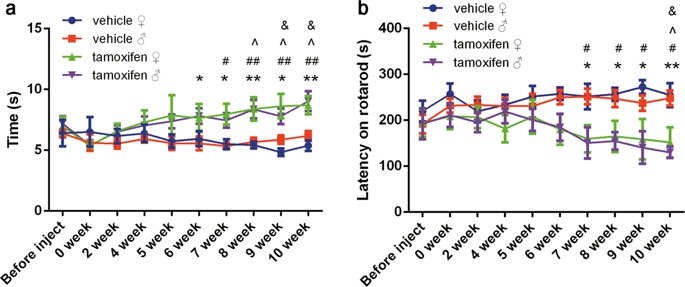当前位置:
X-MOL 学术
›
Acta Pharmacol. Sin.
›
论文详情
Our official English website, www.x-mol.net, welcomes your feedback! (Note: you will need to create a separate account there.)
Development and characterization of an inducible Dicer conditional knockout mouse model of Parkinson's disease: validation of the antiparkinsonian effects of a sigma-1 receptor agonist and dihydromyricetin.
Acta Pharmacologica Sinica ( IF 8.2 ) Pub Date : 2020-02-28 , DOI: 10.1038/s41401-020-0379-5 Chen-Hong Guo 1 , Ting Cao 1 , Long-Tai Zheng 1 , John L Waddington 1, 2 , Xue-Chu Zhen 1
Acta Pharmacologica Sinica ( IF 8.2 ) Pub Date : 2020-02-28 , DOI: 10.1038/s41401-020-0379-5 Chen-Hong Guo 1 , Ting Cao 1 , Long-Tai Zheng 1 , John L Waddington 1, 2 , Xue-Chu Zhen 1
Affiliation

|
Parkinson's disease (PD) is a common neurodegenerative disease characterized by motor impairment and progressive loss of dopamine (DA) neurons. At present, the acute application of neurotoxic drugs such as 1-methyl-4-phenyl-1,2,3,6-tetrahydropyridine (MPTP) and 6-hydroxydopamine (6-OHDA) are commonly used to simulate the pathology of PD; however, it is difficult to induce the progressive pathogenesis of PD with these models. In this study, we employed DAT promoter-mediated Cre transgenic mice to establish tamoxifen-inducible Dicer conditional knockout (cKO) mice in an effort to mimic the progressive loss of DA neurons and the development of PD-like behavioral phenotypes. The results showed that Dicer cKO mice exhibited progressive loss of DA neurons in the substantia nigra (SN) following tamoxifen administration. Significant DA loss was observed 6 weeks after tamoxifen administration; accordingly, progressive motor function impairment was also observed. We also found that a significant neuroinflammatory response, as evidenced by microglial proliferation, another hallmark of PD pathogenesis, accompanied the loss of DA neurons. The acute application of levo-DOPA (L-DOPA) relieved the PD-like motor impairments in Dicer cKO mice to exert its antiparkinsonian action, indicating that the model can be used to evaluate the antiparkinsonian efficacy of PD drugs. To further elucidate the potential application of this novel PD animal model for PD drug development, we employed the powerful neuroprotective agent dihydromyricetin (DHM) (10 mg/kg) and the selective sigma-1 receptor agonist PRE-084 (1 mg/kg), both of which were previously shown to produce antiparkinsonian effects. The results indicated that the chronic administration of either DHM or PRE-084 attenuated the Dicer cKO-induced loss of DA neurons and motor impairments, although the two drugs acted through different mechanisms. These data indicate that the Dicer cKO mouse model may be a useful model for investigating the pathological development of PD and intervention-mediated changes. In conclusion, this transgenic mouse model appears to simulate the progressive pathogenesis of PD and may be a potentially useful model for PD drug discovery.
中文翻译:

帕金森氏病的诱导型Dicer条件性基因敲除小鼠模型的开发和表征:验证sigma-1受体激动剂和二氢杨梅素的抗帕金森效应。
帕金森氏病(PD)是一种常见的神经退行性疾病,其特征在于运动障碍和多巴胺(DA)神经元的进行性丧失。目前,神经毒性药物如1-甲基-4-苯基-1,2,3,6-四氢吡啶(MPTP)和6-羟基多巴胺(6-OHDA)的急性应用通常被用来模拟PD的病理。然而,用这些模型很难诱发PD的进行性发病机理。在这项研究中,我们采用DAT启动子介导的Cre转基因小鼠建立他莫昔芬诱导的Dicer条件性基因敲除(cKO)小鼠,以模拟DA神经元的进行性丧失和PD样行为表型的发展。结果显示,在使用他莫昔芬后,Dicer cKO小鼠在黑质(SN)中表现出DA神经元的进行性丧失。他莫昔芬给药6周后观察到明显的DA损失。因此,还观察到进行性运动功能受损。我们还发现,由小胶质细胞增生(PD发病机理的另一个标志)所证实的是显着的神经炎症反应,伴随着DA神经元的丢失。左旋多巴(L-DOPA)的急性应用缓解了Dicer cKO小鼠的PD样运动损伤,发挥了其抗帕金森病的作用,表明该模型可用于评估PD药物的抗帕金森病功效。为了进一步阐明这种新型PD动物模型在PD药物开发中的潜在应用,我们采用了功能强大的神经保护剂二氢杨梅素(DHM)(10 mg / kg)和选择性sigma-1受体激动剂PRE-084(1 mg / kg) ,先前都证明这两种都产生抗帕金森效应。结果表明,尽管两种药物通过不同的机制起作用,但长期施用DHM或PRE-084可以减轻Dicer cKO诱导的DA神经元丧失和运动障碍。这些数据表明Dicer cKO小鼠模型可能是用于研究PD的病理发展和干预介导的变化的有用模型。总之,这种转基因小鼠模型似乎可以模拟PD的进行性发病机理,并且可能是PD药物发现的潜在有用模型。这些数据表明Dicer cKO小鼠模型可能是用于研究PD的病理发展和干预介导的变化的有用模型。总之,这种转基因小鼠模型似乎可以模拟PD的进行性发病机制,并且可能是PD药物发现的潜在有用模型。这些数据表明Dicer cKO小鼠模型可能是用于研究PD的病理发展和干预介导的变化的有用模型。总之,这种转基因小鼠模型似乎可以模拟PD的进行性发病机制,并且可能是PD药物发现的潜在有用模型。
更新日期:2020-02-28
中文翻译:

帕金森氏病的诱导型Dicer条件性基因敲除小鼠模型的开发和表征:验证sigma-1受体激动剂和二氢杨梅素的抗帕金森效应。
帕金森氏病(PD)是一种常见的神经退行性疾病,其特征在于运动障碍和多巴胺(DA)神经元的进行性丧失。目前,神经毒性药物如1-甲基-4-苯基-1,2,3,6-四氢吡啶(MPTP)和6-羟基多巴胺(6-OHDA)的急性应用通常被用来模拟PD的病理。然而,用这些模型很难诱发PD的进行性发病机理。在这项研究中,我们采用DAT启动子介导的Cre转基因小鼠建立他莫昔芬诱导的Dicer条件性基因敲除(cKO)小鼠,以模拟DA神经元的进行性丧失和PD样行为表型的发展。结果显示,在使用他莫昔芬后,Dicer cKO小鼠在黑质(SN)中表现出DA神经元的进行性丧失。他莫昔芬给药6周后观察到明显的DA损失。因此,还观察到进行性运动功能受损。我们还发现,由小胶质细胞增生(PD发病机理的另一个标志)所证实的是显着的神经炎症反应,伴随着DA神经元的丢失。左旋多巴(L-DOPA)的急性应用缓解了Dicer cKO小鼠的PD样运动损伤,发挥了其抗帕金森病的作用,表明该模型可用于评估PD药物的抗帕金森病功效。为了进一步阐明这种新型PD动物模型在PD药物开发中的潜在应用,我们采用了功能强大的神经保护剂二氢杨梅素(DHM)(10 mg / kg)和选择性sigma-1受体激动剂PRE-084(1 mg / kg) ,先前都证明这两种都产生抗帕金森效应。结果表明,尽管两种药物通过不同的机制起作用,但长期施用DHM或PRE-084可以减轻Dicer cKO诱导的DA神经元丧失和运动障碍。这些数据表明Dicer cKO小鼠模型可能是用于研究PD的病理发展和干预介导的变化的有用模型。总之,这种转基因小鼠模型似乎可以模拟PD的进行性发病机理,并且可能是PD药物发现的潜在有用模型。这些数据表明Dicer cKO小鼠模型可能是用于研究PD的病理发展和干预介导的变化的有用模型。总之,这种转基因小鼠模型似乎可以模拟PD的进行性发病机制,并且可能是PD药物发现的潜在有用模型。这些数据表明Dicer cKO小鼠模型可能是用于研究PD的病理发展和干预介导的变化的有用模型。总之,这种转基因小鼠模型似乎可以模拟PD的进行性发病机制,并且可能是PD药物发现的潜在有用模型。



























 京公网安备 11010802027423号
京公网安备 11010802027423号